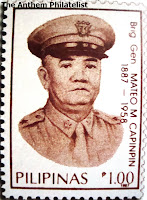The Anthem of St. Pierre and Miquelon
 The Territorial Collectivity of Saint Pierre and Miquelon is a group of small French islands in the North Atlantic Ocean, the main islands being Saint Pierre and Miquelon, south of the Canadian province of Newfoundland and Labrador. The islands are as close as 10 kilometres (6.2 mi) from Green Island, part of Newfoundland.
The Territorial Collectivity of Saint Pierre and Miquelon is a group of small French islands in the North Atlantic Ocean, the main islands being Saint Pierre and Miquelon, south of the Canadian province of Newfoundland and Labrador. The islands are as close as 10 kilometres (6.2 mi) from Green Island, part of Newfoundland.The archipelago has the status of overseas collectivity within France. It is the only remnant of the former colonial empire of New France that remains under French control.
The early settlement of St. Pierre and Miquelon, prized by Europeans for their rich fishing grounds, was characterized by periods of conflict between the French and English.
There is evidence of prehistoric inhabitation on the islands (most likely Beothuk). The European settlements on the islands are some of the oldest in the Americas (with the Spanish and Portuguese settlements), dating from at least the early 16th century. At first Basque fishermen only visited the islands seasonally during the fishing season, but by the mid 17th century there were permanent French residents on the islands.
At the end of the 17th and into the early 18th century, British attacks caused the French settlers to abandon the islands, and the British took possession for 50 years (from 1713 to 1763). The French took back the islands in 1763 under the Treaty of Paris (which ceded all of New France to Britain except for Saint Pierre and Miquelon) and settlers returned to live peacefully for 15 years.
French support of the American Revolution led to a British attack on the islands, and the deportation of the French settlers. Possession of St. Pierre and Miquelon passed back and forth between France and Great Britain for the next 38 years, as the islands suffered attacks by both countries, voluntary or forced removal of the island's residents, and upheaval associated with the French Revolution.
France finally took the islands back after Napoleon's second abdication in 1815, after which followed 70 years of prosperity for the French fishing industry and residents on St. Pierre and Miquelon. However, political and economic changes led to a slow decline of the fishing industry after the late 19th century.
In 1920, a 13-year economic boom began on the islands fuelled by the period of Prohibition in the United States, when St. Pierre and Miquelon became prominent bases for alcohol smuggling. This boom ended with the repeal of Prohibition in 1933, after which the economy sank into depression.
During the Second World War, the governor, Gilbert de Bournat, was loyal to the Vichy regime; he had to negotiate financial arrangements with U.S. authorities to obtain loans guaranteed by the French treasury. At the same time, Canada was considering an invasion of Saint-Pierre and Miquelon. Several pretexts were put forward, notably radio broadcasts of Vichy propaganda. It was alleged that the radio was helping German U-Boats on the Grand Banks, though this was never proven. The Canadian Governor General at the time, The Earl of Athlone, never authorised the implementation of the plans.
Under orders from de Gaulle, Admiral Émile Muselier organised the liberation of Saint-Pierre and Miquelon, without the consent or knowledge of the Canadian and U.S. authorities. On 24 December 1941, a Free French flotilla led by the submarine cruiser Surcouf took control of the islands without resistance, and installed Alain Savary as Governor. De Gaulle had a referendum organised, which was favourable to him, and Saint-Pierre and Miquelon thus became one of the first French territories to join Free France. The affair led to a lasting distrust between De Gaulle and Roosevelt.
Like all departments of France, whether within metropolitan France or overseas (like St. Pierre and Miquelon, off the coast of Newfoundland), "La Marseillaise" is used as the national anthem. (Unlike other nations with second-level administrative areas, French departments are less likely to adopt unofficial regional anthems).
Above is an imperforate proof of the anthem composer, Rouget de Lisle issued by France.






